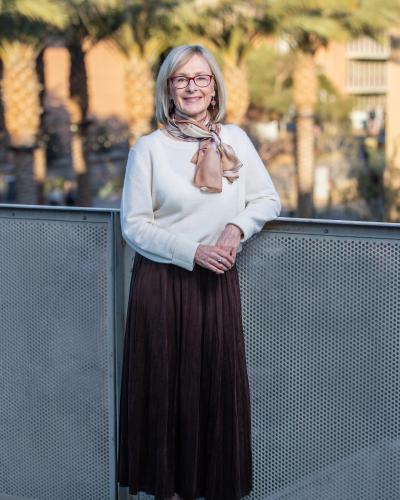Humanities-led international hub comes to ASU
Acknowledge struggles and inequities that started long ago. Develop solutions for global challenges facing the world today. Create a better tomorrow.
Humanities, as a series of disciplines, uses lessons of the past and present to understand how humans can plan for the future. It dives into this metaphorical time travel by investigating the impact of human motivations, behaviors, desires and emotions.
The humanities offer conceptual clarification, theoretical analyses, and critical explorations of who “humans” are, how they live, what motivates them, and how they imagine and work for change. The “way we feel about the world” alters the choices people make, said Joni Adamson, President’s Professor of Environmental Humanities in the Department of English and director of the Environmental Humanities Initiative at the Julie Ann Wrigley Global Futures Laboratory. Adamson is the founding Director of the UNESCO BRIDGES Sustainability Coalition Flagship Hub, which opened its doors during Earth Week 2022 at the new Rob and Melani Walton Center for Planetary Health.
The goal of UNESCO BRIDGES is to go beyond theoretical analysis and connect diverse communities of knowledge and action through project-based activities. It is the first humanities-led international sustainability science initiative within UNESCO. Adamson credits the work of the Humanities for the Environment (HFE) Observatories Network that she launched in 2013 with Sally Kitch, University and Regents Professor of women and gender studies, founding director of the Institute for Humanities Research and the Humanities Lab at ASU, as central to the creation of BRIDGES. The HFE network, alongside UNESCO’s Management of Social Transformations (MOST) Programme and the International Council for Philosophy and Human Sciences, are the co-founding partners of BRIDGES.
“The really exciting thing about BRIDGES is that the humanities have not been central to sustainability sciences, and now they will be. The humanities disciplines have a 360-degree perspective. We look all around—we’re conscious that where we’ve been could be very instructive for where we’re going,” Adamson said.
The BRIDGES Flagship Hub at ASU received a major strategic grant from President Michael M. Crow and administrative support from Peter Schlosser, vice president and vice provost of the Global Futures Laboratory. One of the primary activities of the Flagship Hub at the Global Futures Laboratory will be the BRIDGES Labs, which will partner with ASU’s Humanities Labs led by Kitch. The labs will use transdisciplinary, socially embedded course projects to broaden sustainability science, drawing on the expertise of all academic fields, as well as local, traditional and Indigenous knowledge systems. Students will develop solutions to global challenges through community-facing initiatives where they will learn to work with local stakeholders in respectful, culturally sensitive and effective ways so that the communities are leading the efforts.
The international secretariat of BRIDGES will be led by founding Executive Director Steven Hartman, visiting professor in history and philosophy at University of Iceland. Hartman will be based at the UNESCO headquarters in Paris, as well as the Flagship Hub in ISTB7. Adamson will work closely with Hartman to anchor a cohesive network of global and regional hubs. The BRIDGES hub will bring global attention to ASU, she said. “When people look for expertise in the humanities—at the United Nations, Future Earth, International Science Council and other international organizations—they will look to BRIDGES and the Flagship Hub at ASU. In other words, they’ll be looking at ASU and this Flagship Hub that is networked all the way around the world,” Adamson said. “As host of UNESCO’s BRIDGES Sustainability Coalition, the Global Futures Laboratory becomes a powerful engine in building significant new capacities in the humanities, social sciences, arts and educational sciences at ASU and beyond.”
Note: This story first appeared in Global Futures: Futurecast and is republished here by permission.
Image 1: ASU Newsroom photo of Joni Adamson by Deanna Dent.
Image 2: The Interdisciplinary Science and Technology Building 7 (ISTB7), recently christened the Rob and Melani Walton Center for Planetary Health, is an approximately 281,000 gross-square-foot research facility with activities focusing on the sustainability of food, water and energy. It sits at the corner of University Drive and Rural Road—one of the businest intersections in the state. Designed to be “of the desert,” not just “in the desert,” the building’s appearance mimics a geode, with a hard, sand-colored exterior and vibrant, jewel-toned interior. It preserves the area's heritage in an ancestral canal running underneath the building—less than 50% of the building touches the ground—and by incorporating ancient knowledge about shading. At the same time, it uses 21st-century thermodynamics that will enable the structure to consume less energy while it shields its occupants from heat. In addition to public outreach and exhibit spaces, the Rob and Melani Walton Center for Planetary Health houses the Julie Ann Wrigley Global Futures Laboratory and Global Institute of Sustainability along with a host of other units. The building includes classrooms, a conference center with a 389-seat presentation hall, and research labs for biological sciences, engineering, life sciences and sustainability. Dry lab space may include computing, cyber-security, engineering design and fabrication, and robotics. It is on track for LEED V4 Platinum certification. Photo by Charlie Leight/ASU News.


